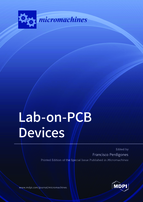Lab-on-PCB Devices
A special issue of Micromachines (ISSN 2072-666X). This special issue belongs to the section "E:Engineering and Technology".
Deadline for manuscript submissions: closed (28 February 2022) | Viewed by 43136
Special Issue Editor
Interests: integration of sensors and/or actuators on lab-on-PCB platforms; marketable lab-on-PCB devices; biomedical and chemical applications; PCB-MEMS devices
Special Issues, Collections and Topics in MDPI journals
Special Issue Information
Dear Colleagues,
Lab-on-PCB has been the subject of increasing research over the last years. These devices emerge as a promising evolution of “lab on a chip” and the “PCB-MEMS” technology. They share important properties with lab-on-chip devices, that is, small fluid volume and rapid response time. In addition, lab-on-PCB is particularly interesting due to the integration of microfluidics, electronics, sensors and actuators in the same platform. Apart from the integration, the interest lies in the commercial availability of the PCB substrate with very reasonable dimensions at low cost. This fact makes lab-on-PCB devices an attractive choice from the market point of view. However, lab-on-PCB is far from being robust. Unlike microelectronic chips, lab-on-PCB devices require a highly multidisciplinary R&D group, and they are lack of standardization for both design and end-user interfaces. Finally, the core of lab-on-PCB devices is based on the integration of sensors (both for measuring the results of a reaction, and for controlling the parameters of the samples, if necessary) and actuators. The actuators are intended for moving the samples through the lab on PCB and for conditioning the samples.
Accordingly, this Special Issue seeks to showcase research papers and review papers that especially focus on the integration of sensors and/or actuators on lab-on-PCB platforms. Topics related to lab-on-PCB that can be accepted include but are not limited to:
- Integration of sensors and/or actuators on lab-on-PCB platforms
- Mass-production fabrication processes of lab-on-PCB devices and techniques
- Cell cultures on lab-on-PCB devices
- Organs on a PCB
Papers reporting integrated sensors and actuators on biomedical or chemical lab-on-PCB platforms with microfluidic control of the samples are especially welcomed.
We look forward to receiving your submissions!
Prof. Dr. Francisco Perdigones
Guest Editor
Manuscript Submission Information
Manuscripts should be submitted online at www.mdpi.com by registering and logging in to this website. Once you are registered, click here to go to the submission form. Manuscripts can be submitted until the deadline. All submissions that pass pre-check are peer-reviewed. Accepted papers will be published continuously in the journal (as soon as accepted) and will be listed together on the special issue website. Research articles, review articles as well as short communications are invited. For planned papers, a title and short abstract (about 100 words) can be sent to the Editorial Office for announcement on this website.
Submitted manuscripts should not have been published previously, nor be under consideration for publication elsewhere (except conference proceedings papers). All manuscripts are thoroughly refereed through a single-blind peer-review process. A guide for authors and other relevant information for submission of manuscripts is available on the Instructions for Authors page. Micromachines is an international peer-reviewed open access monthly journal published by MDPI.
Please visit the Instructions for Authors page before submitting a manuscript. The Article Processing Charge (APC) for publication in this open access journal is 2600 CHF (Swiss Francs). Submitted papers should be well formatted and use good English. Authors may use MDPI's English editing service prior to publication or during author revisions.
Keywords
- lab on PCB
- sensors integrated on lab on PCB
- actuators integrated on lab on PCB
- cell culture on lab on PCB
- organ on a PCB
- biomedical application
- chemical application







